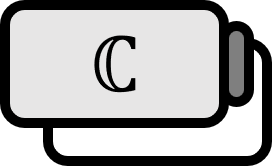Integration of Complex Functions
Definition 1
$$ g(t) := p(t) + i q(t) \qquad , t \in [a,b] $$
Let’s assume for a real function $p, q : [a,b] \to \mathbb{R}$, a complex function $g : [a,b] \to \mathbb{C}$ is expressed as above. The definite integral from $[a,b]$ to $g$ is defined as follows. $$ \int_{a}^{b} g(t) dt = \int_{a}^{b} p(t) dt + i \int_{a}^{b} q(t) dt $$ For $t \in [a,b]$, the complex path integral following the path $\mathscr{C} : z(t) = x(t) + i y(t)$ is defined as: $$ \int_{\mathscr{C}} f(z) dz = \int_{a}^{b} f \left( z(t) \right) z’(t) dt $$
Description
While the definition of an arc or curve $\mathscr{C} : z(t)$ might be important in geometry, it isn’t particularly necessary to be exact for complex analysis, so we can somewhat overlook it. Instead of insisting on the explanations below, better to study curves properly in differential geometry and for now, it is sufficient to intuitively grasp the concept for $\mathscr{C}$.
If there is no overlap in $\mathscr{C}$, meaning the following is satisfied, it is called simple or Jordan. $$ z \left( t_{1} \right) = z \left( t_{2} \right) \implies t_{1} = t_{2} \qquad , \forall t_{1}, t_{2} \in [a,b] $$
If it’s differentiable everywhere and the derivative is not $0$, meaning the following is satisfied, it is considered smooth. $$ \exists z’(t) \ne 0 \qquad , \forall t \in [a,b] $$
Joining the ends of a finite number of (simple) smooth arcs results in a (simple) contour. Though translating this as a contour line might not convey the meaning well and in the context of complex analysis, it’s commonly used in situations where integrating along the contour in an anticlockwise direction, it could also be simplified as a path for $\mathscr{C}$.
When moving in the direction of $a \to b$ if it’s $\mathscr{C}$, then when moving in the direction of $b \to a$ it’s expressed as $-\mathscr{C}$. With parameters, it is as follows when $\mathscr{C} : z(t) , a \le t \le b$. $$ -\mathscr{C} : z(-t) , -b \le t \le -a $$
If only the exact positions of the endpoints are the same, that is, $z(a) = z(b)$ it is called a closed contour.
Let me emphasize once more. Even if these explanations are not appealing to a good mathematician, skip them. It’s much more crucial if you can intuitively accept the following properties.
Basic Properties
Let’s say $f,g$ is piecewise continuous in $\mathscr{C}$.
- [1]: For every $\alpha , \beta \in \mathbb{C}$ $$ \int_{\mathscr{C}} \left( \alpha f(z) + \beta g(z) \right) dz = \alpha \int_{\mathscr{C}} f(z) dz + \beta \int_{\mathscr{C}} g(z) dz $$
- [2]: If the direction of $\mathscr{C}$ is $a \to b \to c$ and consists of $\mathscr{C}_{1}$ in the direction of $a \to b$ and $\mathscr{C}_{2}$ in the direction of $b \to c$ $$ \int_{\mathscr{C}} f(z) dz = \int_{\mathscr{C}_{1}} f(z) dz + \int_{\mathscr{C}_{2}} f(z) dz $$
- [3]: If the direction is reversed, the sign is reversed. $$ \int_{ - \mathscr{C}} f(z) dz = - \int_{\mathscr{C}} f(z) dz $$
Osborne (1999). Complex variables and their applications: p69~71. ↩︎
